Different poultry raisers prefer various breeds for a variety of reasons. Some might choose more common breeds for their delicious flesh and egg-laying ability. So, what could be the reasons to consider growing exotic chicken breeds?
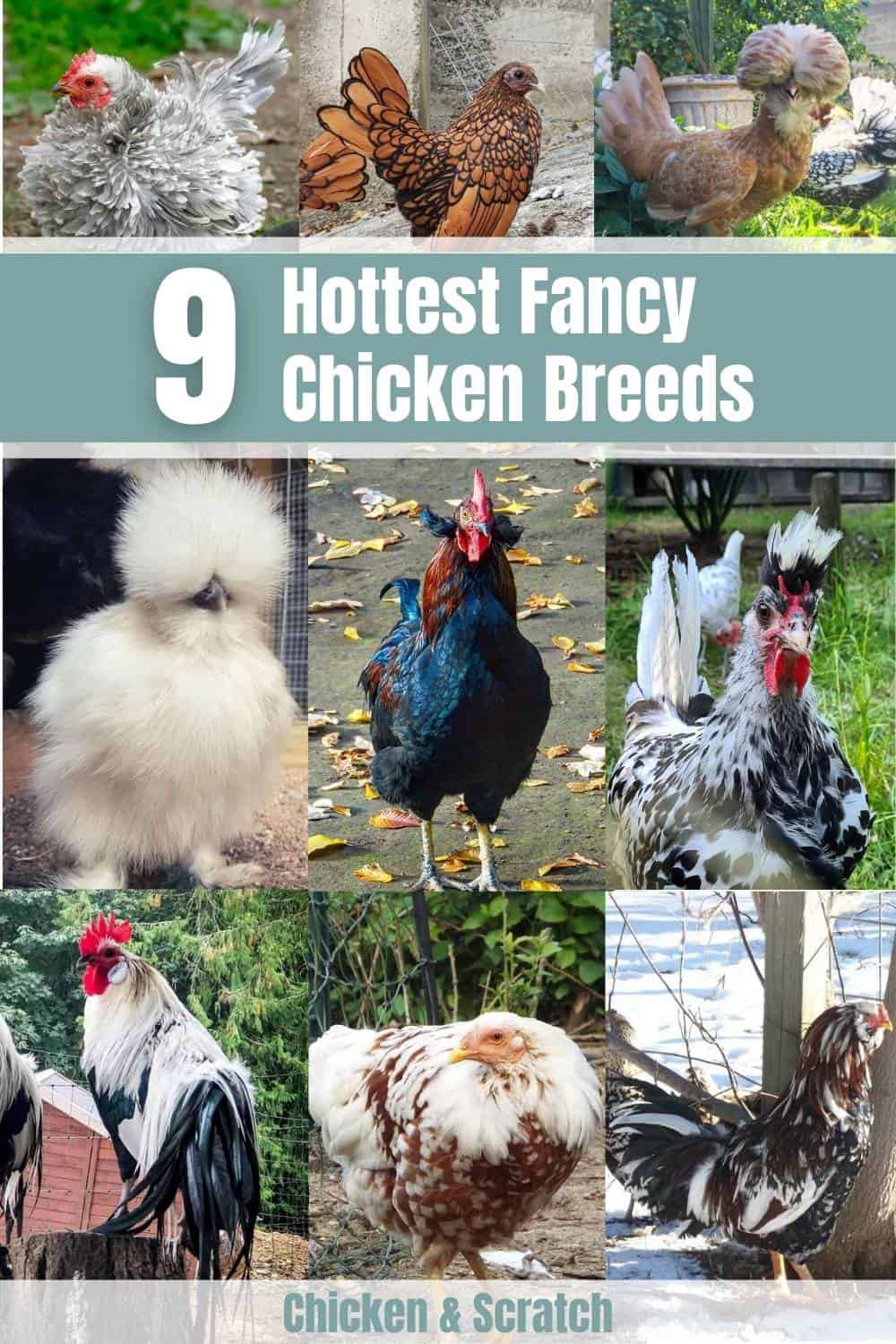
Each chicken breed from exotic lines has its unique traits. Breeders choose these elegant hens not only for their beauty but also for their competitive edge in chicken contests and exhibits around the world.
How To Raise Fancy Chicken Breeds
It may be tempting to add some fancier chicken breeds to your backyard flock. However, there are many important factors to consider while raising decorative chicken breeds. Specific characteristics of several of these breeds need unique modifications. As a result, these beautiful hens may need separate enclosures best suited to their particular features.
When considering whether to keep these lovely chicken breeds in your coop, temperature, and environment must also be analyzed. Some of these exotic birds are adapted to warmer climes, while others can survive in cold temperatures. Conversely, some exotic hens cannot survive in a hotter environment.
For instance, the Serama hens are small, necessitating the use of smaller housing. Likewise, Frizzles, Polish, and Silkies hens need protection from rain or water due to their inability to tolerate damp conditions.
Therefore, before you bring your chicken breeds home as pets, arm yourself with knowledge on how to keep your fowls happy and healthy. We’ve compiled a list of nine decorative species that you may include in your coop.
1. Silkie Chicken

| Feature | Details |
| Purpose | Ornamental |
| Egg Color | White
Tinted Cream |
| Egg Size | Small to Medium |
| Broodiness | Broody |
| Heat Tolerance | Yes (Moderate) |
| Cold Tolerance | Yes |
| Comb Type | Walnut Comb |
| Egg Production | About 100 to 120 eggs per year |
| Chicken Skin Color | Bluish black
Dark |
| Life Span | 7-9 years |
| Adult Weight | Hen: 3-4 lbs, Rooster: 4-5 lbs |
| Backyard Friendly | 4/5 |
The name “Silkie” originates from the bird’s unusual, soft, and silky feathers. Additionally, Silkie’s five toes on each foot, blue earlobes, black skin, beak, and bones add to her uniqueness! Additionally, a Silkie chicken has feathered legs and feet and a protruding crest on top of its head.
Background and History of Silkie

The exact origins of this chicken breed are unclear, but it’s known that they have existed for hundreds of years. Some experts and breeders suggest that the Silkie may have originated in China, India, or Japan. Nonetheless, the particular site of the breed’s development remains unknown.
This opulent chicken made its way to Europe 200 years ago. And it made its way to the United Kingdom in the mid-1880s. TThis breed was recognized by the American Poultry Association and included in their Standard of Perfection in 1874.
At the moment, the Silkie is the most popular and widely distributed ornamental chicken breed worldwide. They are developed for both show and decorative reasons by breeders. Do not be misled since this breed also comes in bantam size.
Silkie Chicken Characteristics and Temperament
The Silkie or Silky is a little chicken with a vast, spherical body covered with downy feathers. Their physical characteristics provide them with a one-of-a-kind look as attractive birds. Additionally, their plumage seems to be more akin to fur than feathers. It is because their plumage is devoid of barbicels. That is also why they are unable to fly.
It’s important to note that Silkie is often misidentified in other nations as a bantam chicken. Silkie is a prevalent species of large chicken. Silkies come in two distinct varieties: Bearded and Unbearded.
Additionally, this chicken breed comes in a variety of colors. For exhibitions and contests, the colors white, black, buff, shade, partridge, and blue are more popular. Silkie is also available in cuckoo, lavender, red, and splash.
Their distinctiveness is further enhanced by their five-toed feature, which is not typical among chickens that usually have a four-toed appearance. However, other chicken breeds, such as the Dorking, Faverolles, and Sultan, also have their own distinctive characteristics.
Breed Standard and Appearance

According to the American Poultry Association’s Standard of Perfection, all Silkie hens should have turquoise blue earlobes, a tiny walnut comb that ranges in hue from deep blue to black, and dark wattles.
Standard roosters weigh about 1.8 kg, while hens weigh approximately 1.36 kg. Because Silkie cannot fly, you may confine them with a low fence. They do not harm if you live in a free-range area (or very little). These hens are friendly, trustworthy, and calm.
However, they are poor egg layers. In a year, they lay an average of 120 cream or colored eggs. Nonetheless, they are excellent mothers and spend the majority of their time broody. Additionally, Silkies are well-known for hatching eggs from other birds.
They are devoted mother hens, and if you have Silkie mothers in your coop, you will not need an incubator. Breeders regard them as the ideal organic incubator. Silkie chickens may reduce their egg production during extreme temperatures, including the hot summer months.
Since Silkie’s feathers are not waterproof, they should perpetually be put in a dry environment. They thrive in captivity and are cold-hardy; they are lovely pets, particularly for children. Silkie meat is also used medicinally in other nations due to its black skin and bones. Silkie chickens live up to nine years.
2. Polish Chicken
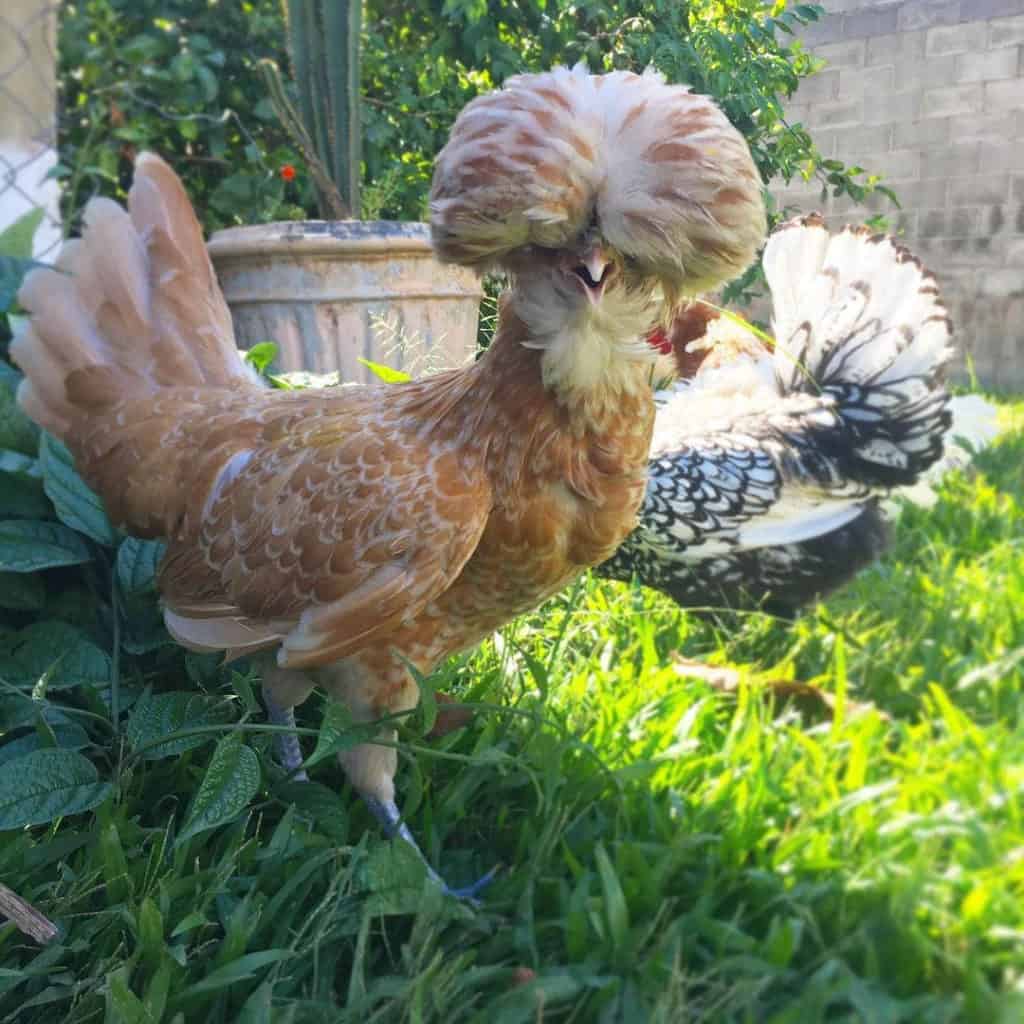
| Feature | Details |
| Purpose | Ornamental |
| Egg Color | White |
| Egg Size | Small to Medium |
| Broodiness | Not Broody |
| Heat Tolerance | Yes |
| Cold Tolerance | Yes |
| Comb Type | V-shaped Comb |
| Egg Production | About 100 to 150 eggs per year |
| Chicken Skin Color | Yellow |
| Life Span | 8-9 years |
| Adult Weight | Hen: 3-4 lbs, Rooster: 4-5 lbs |
| Backyard Friendly | 4/5 |
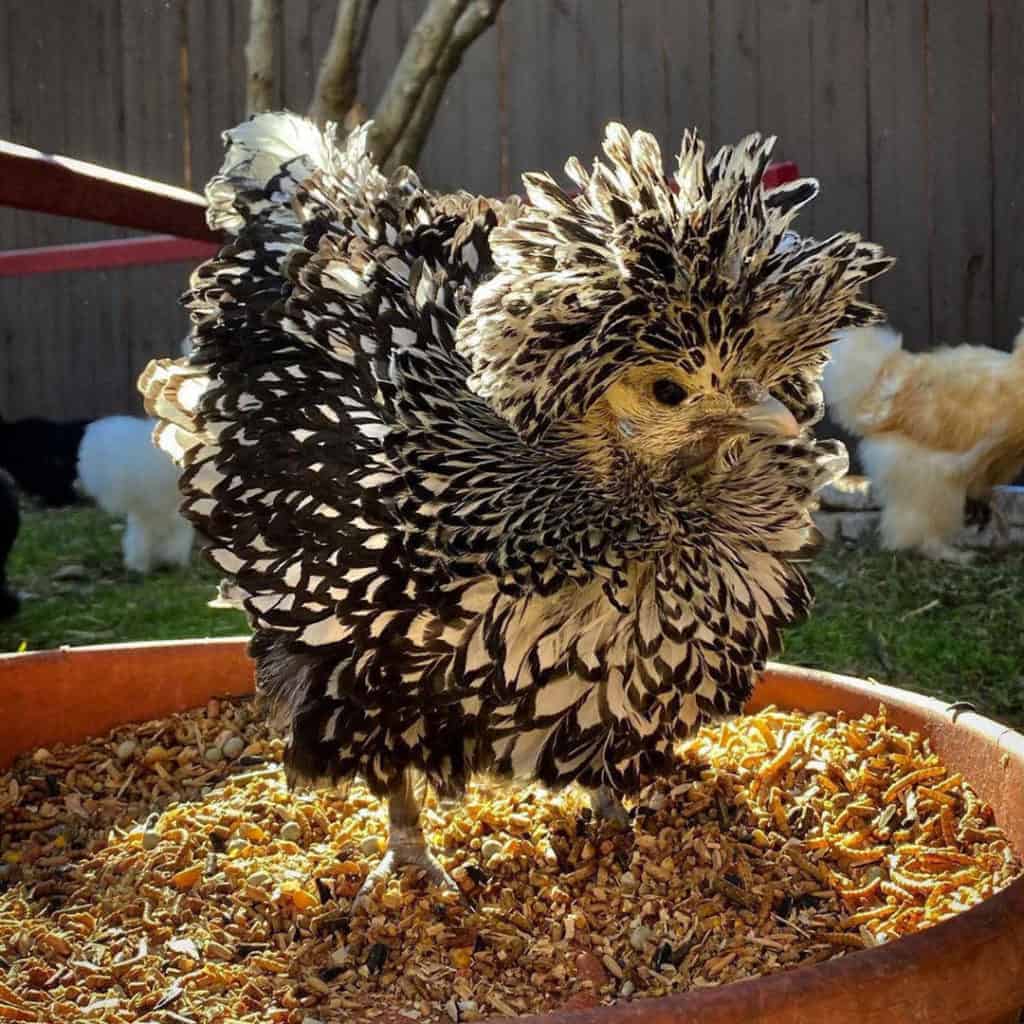
Polish chicken is well-known for its enormous crest that completely covers its head. This is one of the most stunning ornamental chicken breeds available. This chicken’s exact origins are unknown, except that it is a European breed.
Background and History
In 1874, the American Poultry Association included three Polish variants into its Standard of Perfection. Later, they recognized more kinds. Despite not originating in Poland, it might lead to the question: how did it get its name? The breed is named for its tufted crests that resemble the feathered caps worn by Polish soldiers in the past.
Polish chickens, according to breeders and specialists, came to the United States between 1830 and 1840. Throughout this time, American farmers preferred growing these chicken varieties, which quickly gained popularity. Around the 1700s, it gained popularity in England. Polish chickens are mainly utilized as display or decorative breeds at the moment.
Characteristics and Temperament
Polish hens have a small V-shaped comb with a brilliant hue. However, they are most well-known for their unusual appearance, which includes a massive yet beautiful crest. Additionally, their wattles are tiny and glowing red.
Their beard and crest conceal both their wattles and earlobes. It is because they also have small white earlobes. While Polish chickens come in various hues, the color of their legs and skin can vary depending on the specific breed variation.
The American Poultry Association recognized several Polish color variations, including Bearded White, Bearded Golden, Bearded Silver, Bearded Buff Laced, White Crested Black, Non-Bearded Golden, Non-Bearded White, Non-Bearded Silver, and Non-Bearded Buff Lace. Polish plumage color varies according to variety.
Breed Standard and Appearance
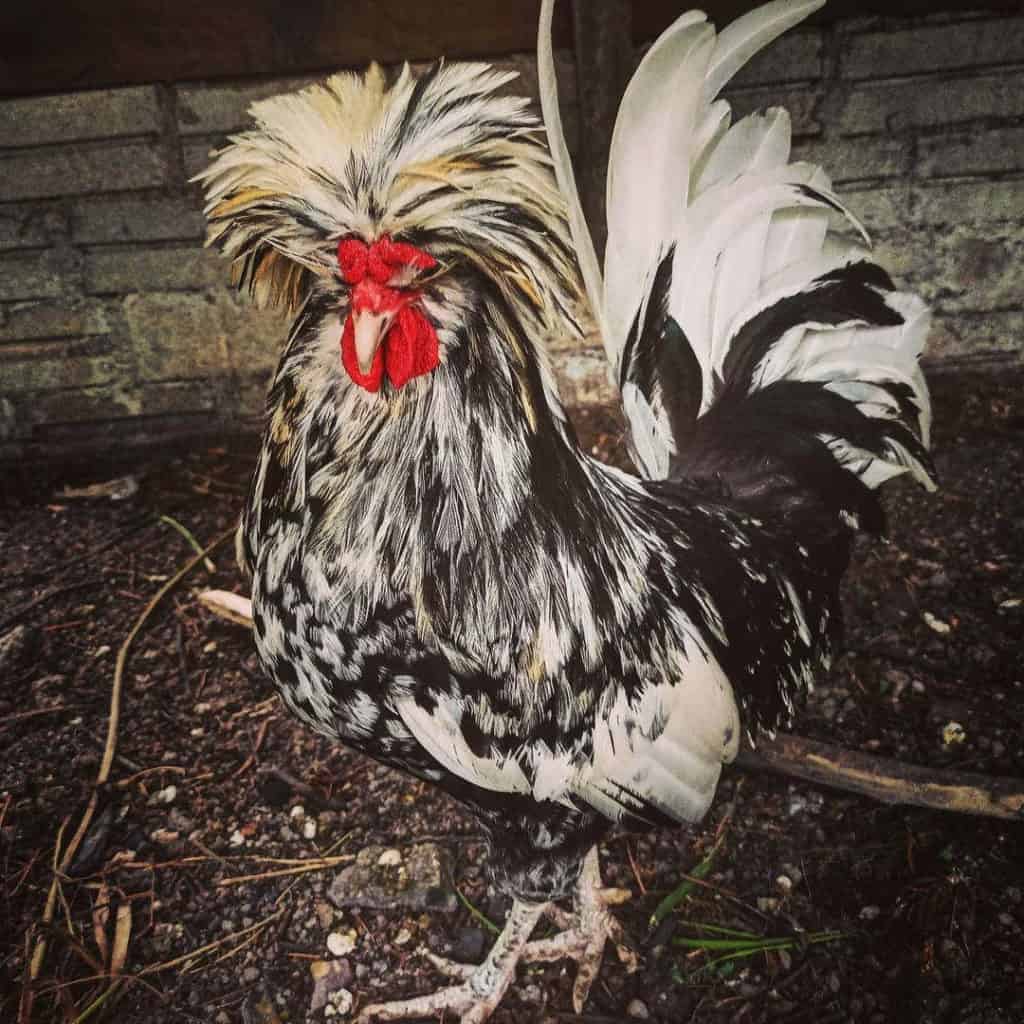
Polish standard roosters weigh about 2.75 kg, while hens weigh approximately 2 kg. At the same time, its bantam roosters weigh about 0.85 kilograms, and its hens approximately 0.74 kilograms.
While some Polish chicken breeds are decent egg layers, they are mainly prized for their ornamental value. Their eggs are whitish and medium in size. These hens seldom become broodies, but they are also notorious non-sitters.
Because they often have eyesight difficulties resulting from their enormous crest, they are easily startled and constantly anxious. As a result, they are also vulnerable to above-ground predators—whistle or hum to warn these hens of your approach to avoid them becoming startled.
Additionally, these breeds are prone to eye infection, particularly when their crest, which drapes directly over their eyes, becomes damp and filthy. Breeders should often inspect their ridge for cleanliness.
Conditions in their eyes will render them unable to locate their water or food. They make excellent pets since they are tame, friendly, and gentle. However, these Polish chickens may be unpredictable and loud at times.
3. Frizzle Chicken

| Feature | Details |
| Purpose | Ornamental |
| Egg Color | White
Brown Cream |
| Egg Size | Medium |
| Broodiness | Broody |
| Heat Tolerance | Yes |
| Cold Tolerance | Yes |
| Comb Type | Varies |
| Egg Production | About 150 to 200 eggs per year |
| Chicken Skin Color | White |
| Life Span | 5-8 years |
| Adult Weight | Hen: 3-4 lbs, Rooster: 4-5 lbs |
| Backyard Friendly | 5/5 |
Frizzle is perhaps best known for its show breeds. They lay an average of 150 to 200 eggs each year yet are adept at brooding. Nonetheless, their unique feathers make them easily identifiable by selected breeders or even the general public.
Background and History
Frizzle’s delicate feathers are a variety of pastel hues and are fluffy yet curled outward, adding to its distinctive appearance. Their shades are typically white. They are just incredibly cuddly and adorable!
These non-aggressive fowls thrive in either a free-range or restricted habitat. They are excellent house pets since they are non-demanding and always cheerful animals.
Frizzle is a one-of-a-kind chicken breed. It is due to the bird’s wiry or wrinkled plumage. You may be startled to encounter a Frizzle chicken that has just gone the wrong way during a wind storm. Again, this is owing to the curvature of its plumage.
The Frizzle chicken’s origins are unknown. Though other breeds having frizzle traits, like the Pekin and Polish, originated in Asia. According to historical accounts, this chicken originated in the Far East in the 18th century. Additionally, it is the consequence of breeder selection.
Apart from Australia, nine European nations recognize Frizzle as a distinct breed. The United Kingdom, Ireland, France, Germany, Belgium, Italy, Poland, the Czech Republic, and Slovakia are involved in this group. Frizzle is not known as a separate breed in the United States.
Characteristics and Temperament
The Frizzle chicken comes in a variety of variations, and some share characteristics with the Cochin chicken. Due to its weight, it may reach the same size as the Plymouth Rock chicken. However, it also comes in bantam size.
With its erect breed, you’d assume Frizzle chicken is nobility. It does, however, have a short, broad body with a large, generous breast, individual feathers curve backward toward the head, and its neck is densely stuffed with wrinkled feathers.
Their wings are long, but they lack feathers on their legs. They are available in various colors and have three distinct plumage varieties, but all have large upright tails. Frizzle hens have three distinctive plumages: frizzled, excessively frizzled, and flat-coated.
They all have red eyes, a medium-sized single red comb, red wattles, and red earlobes. However, the color of the chicken’s legs varies according to the diversity of Frizzle’s hues.
Frizzles with darker feathers also have darker legs. The beak is the same shade as the feathers. Buff, Pyle, red, white, and Columbian types have yellow beaks; black, blue, black-red, and cuckoo kinds have white beaks.
Breed Standard and Appearance
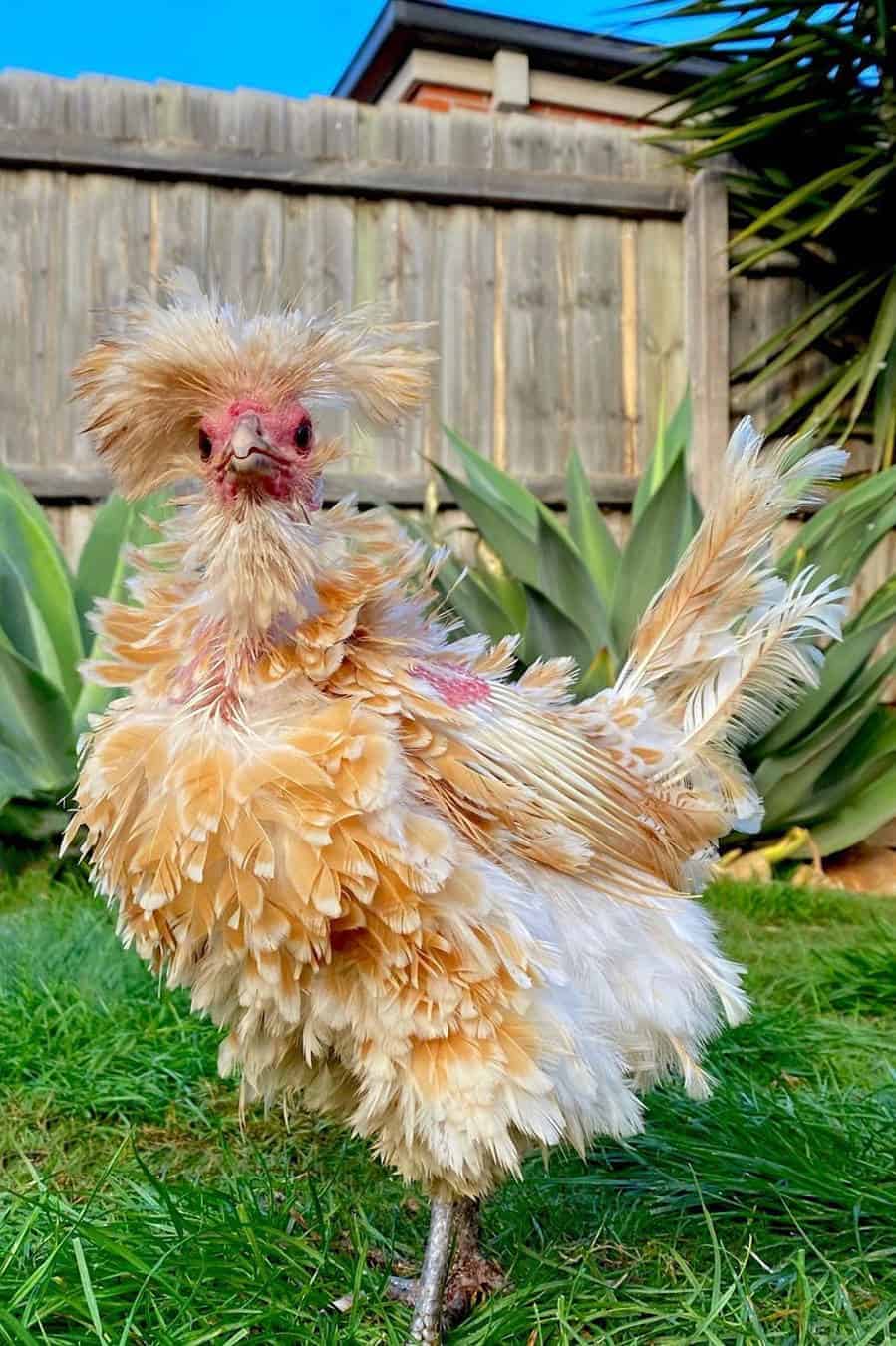
The typical Frizzle cock weighs between 7.05 and 7.94 lbs, while the hens weigh between 4.96 and 5.95 lbs. The bantam rooster weighs between 1.5 and 1.74 lbs, while the hens weigh between 1.26 and 1.5 lbs. This rare kind of chicken matures rapidly. Frizzles are a large breed. Although they are ideal for display, they also provide excellent meat and eggs.
With their white or colored eggs, the chickens are excellent layers. They often become broody as well. When the chicks hatch, they seem “typically feathered” until their feathers develop and curl outwards.
Due to Frizzle’s prowess as a scavenger, they thrive in a free-range or outdoor pen habitat. They may, however, function effectively in captivity as well. Additionally, they can survive in any climate.
4. Sebright Chicken
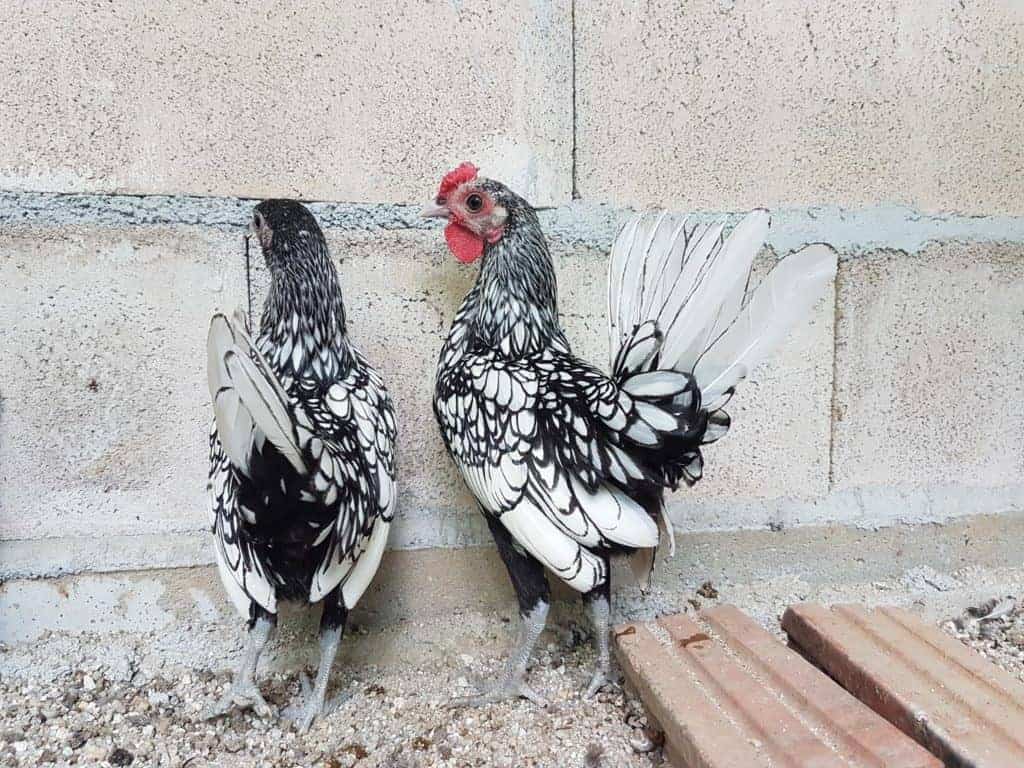
| Feature | Details |
| Purpose | Ornamental |
| Egg Color | White
Cream |
| Egg Size | Small |
| Broodiness | Not Broody |
| Heat Tolerance | Yes |
| Cold Tolerance | Yes |
| Comb Type | Rose Comb |
| Egg Production | About 100 to 120 eggs per year |
| Chicken Skin Color | White |
| Life Span | 6-8 years |
| Adult Weight | Hen: 1.4-1.5 lbs, Rooster: 1.1-1.3 lbs |
| Backyard Friendly | 4/5 |
Sebright chickens are one of the natural bantam chicken breeds that began in the United Kingdom. This chicken is one of the oldest British true bantam breeds of chicken.
Background and History
Sir John Saunders Sebright, who created the breed in the early 1800s, gave it its name. It is the only chicken named after a specific person. Sir Sebright established this breed intending to produce an exhibition fowl with a magnificent plumage.
However, the precise fowls utilized to create this breed are unknown. It is assumed that the Hamburg, Nankin, Polish, and Rosecomb chicken breeds were used to develop the Sebright breed.
The Sebright chicken breed was approved by the American Poultry Association’s Standard of Perfection in 1874. According to the American Bantam Association, it is one of the most popular bantam breeds. At the moment, breeders primarily raise Sebright for aesthetic purposes.
Characteristics and Temperament
For enthusiasts, Sebright is well-known not just for its beautiful plumage but also for its kind disposition. Unlike other chickens, this is the only chicken breed in which males lack a pointed hackle and tail. Sebright comes in two color varieties: golden and silver. Each feather in both kinds is marked in black.
Sebright chickens are distinguished by a short back and a prominent breast. Their tail is angled slightly upward and is widely spread. They feature a crimson rose comb that culminates in a straight spike and broad, sloping wings.
Breed Standard and Appearance
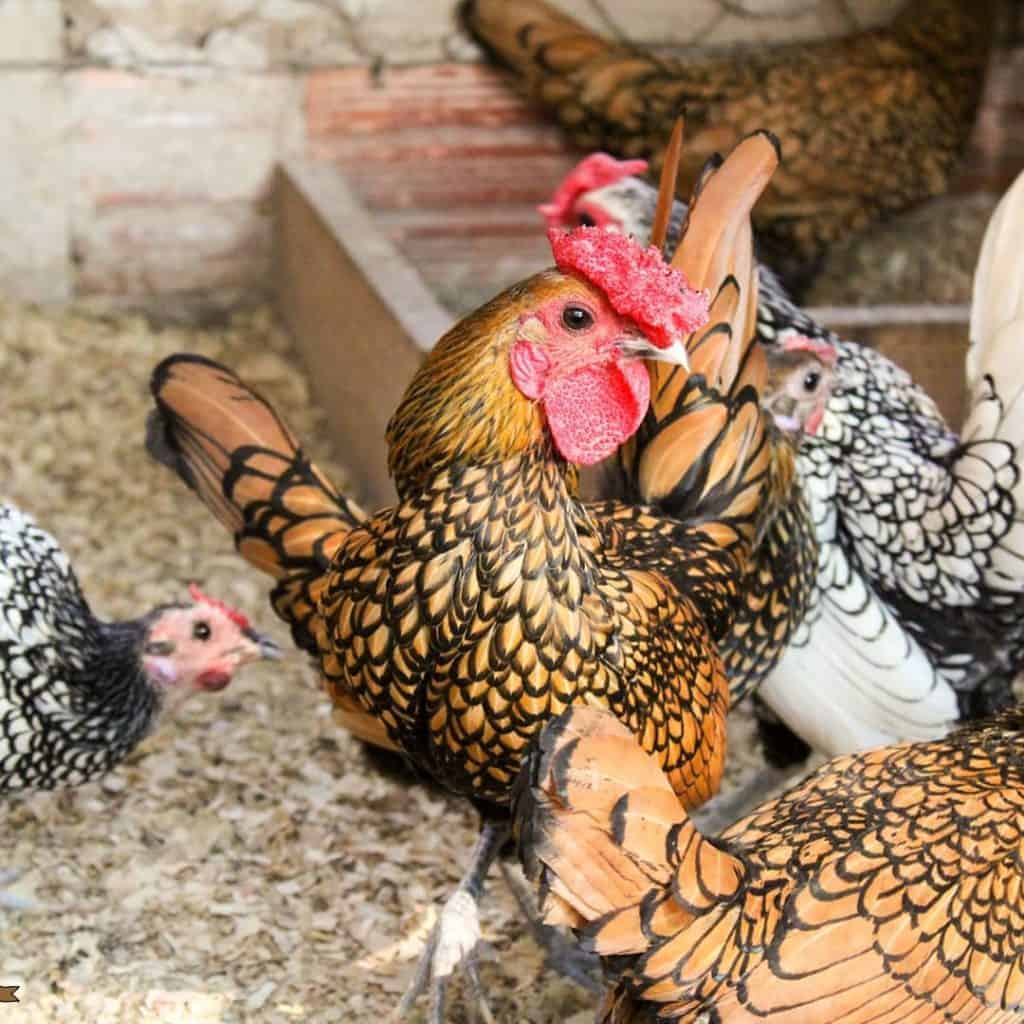
Sebright’s earlobes are turquoise or purplish-red, and his legs are blue. Hens’ faces are gypsy-colored, while roosters’ faces are purple-red. The roosters weigh about 0.62 kg, while the hens weigh approximately 0.57 kg.
Sebright roosters are not aggressive, even though they are busy birds in general. They are pleasant and friendly hens. They, like the majority of tiny chickens, are likewise fearful. Do not underestimate Sebright chickens since they have enormous wings and are excellent fliers even when they are young.
That is why the majority of breeders choose to keep them confined. They like to roost on trees if there are some around. Sebright also does well in captivity. Additionally, they are excellent scavengers.
However, these birds are not wonderful egg layers, and their flesh is likewise not exceptional. They are solely suitable for decorative purposes. Because hens seldom get broody, they have a high mortality rate for chicks. While adult Sebright is a pleasant and energetic buddy, he is in danger of developing Marek’s illness.
5. Russian Orloff
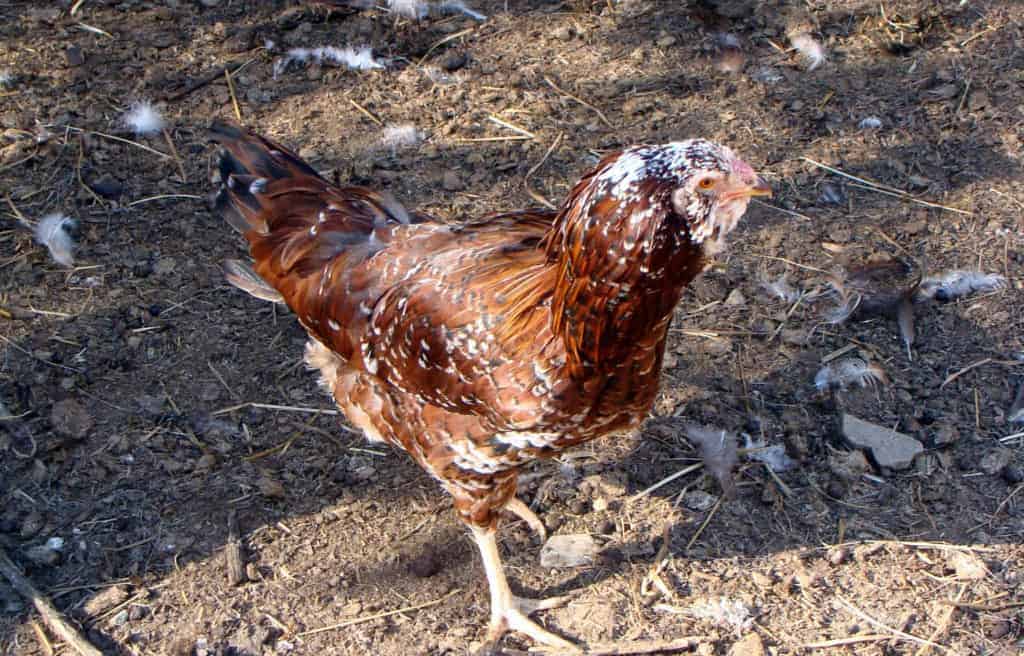
| Feature | Details |
| Purpose | Dual-purpose |
| Egg Color | Brown |
| Egg Size | Medium to Large |
| Broodiness | Usually Broody |
| Heat Tolerance | Yes |
| Cold Tolerance | Yes |
| Comb Type | CushionComb |
| Egg Production | About 150 to 180 eggs per year |
| Chicken Skin Color | Yellow |
| Life Span | 7-9 years |
| Adult Weight | Hen: 5-6 lbs, Rooster: 7-8 lbs |
| Backyard Friendly | 5/5 |
The Russian Orloff is an endangered chicken with a colorful history and distinctive look. It is also attributed to simply as the Orloff or the Russian. However, it is now widely accepted that Orloff’s ancestors were Persian, not Russian. However, this bird’s fascinating history has helped it retain its Russian moniker.
Background and History

The Russian Orloff, which originated in Persia in the 17th century, spread across Asia and Europe throughout the century. Contrary to common belief, the bird did not achieve great appeal until about 200 years later. After being brought to the West by Count Orlov of Russia, the breed became associated with Russia and the count, giving the chicken its current moniker.
As a result, the chicken is often considered to be of Russian origin. It was assumed to be the case until very recently when Orloff’s Persian past was revealed. This chicken received improvement after its introduction to Germany in the early 1900s. Indeed, German breeders went so far as to develop the first miniature Orloff bantam breed during this period.
Presented to the United Kingdom in the early 1900s and ultimately accepted to the American Poultry Association’s Standard of Perfection, the chicken was later discarded from the organization. Due to the contraction in the notoriety of the Russian Orloff over the years, especially in the West, the chicken was no longer a popular option among breeders.
Thus, the chicken has been withdrawn from the restricted APA Standard and ranked as severely endangered by the Livestock Conservancy.
Interestingly, it is thought that the Russian Orloff gained popularity in America before its introduction in Europe, thus clouding its demise. Indeed, given the period between 1875 and 1894, during which the chicken was introduced in the Standard of Perfection, it is evident that the breed had to be brought to America long before it was presented to the rest of Europe in the 1900s.
Characteristics and Temperament
Russian Orloffs are renowned for being quiet and peaceful, making them an excellent choice for people seeking a low-maintenance chicken. However, they are not very friendly, which means they are unlikely to desire to snuggle with their owners.
However, some Orloff chicks are known to be as cuddly and devoted as family pets, so this is a case-by-case basis. These hens are especially well-known for their unaggressive dispositions, ranging from easygoing to sociable.
Although Russian Orloffs are not hostile and are usually peaceful, they are not easily intimidated and will likely defend themselves when challenged by more aggressive chickens.
Yet, these chickens are unlikely to initiate conflict and generally avoid more aggressive chicken varieties rather than fight with them. This chicken loves free-range, often assisting farmers in eradicating pests such as fire ants and earwigs.
The Russian Orloff is very docile and adapts well to captivity, and also does well outdoors in the winter. Their generally amiable dispositions and cold hardiness make them choose many chicken breeders trying to reintroduce this gentle bird.
6. Onagadori (Phoenix Chicken)

| Feature | Details |
| Purpose | Ornamental |
| Egg Color | White
Cream Light Brown |
| Egg Size | Medium to Large |
| Broodiness | Not Broody |
| Heat Tolerance | Yes |
| Cold Tolerance | Yes |
| Comb Type | Single Comb |
| Egg Production | About 150 to 180 eggs per year |
| Chicken Skin Color | Yellow |
| Life Span | 7-9 years |
| Adult Weight | Hen: 3-4 lbs, Rooster: 4-5 lbs |
| Backyard Friendly | 3/5 |
Phoenix chickens are molting birds that molt once or twice a year. Molting is the process through which hens shed their feathers and regenerate them. This process happens more often as the days get shorter. During molt, chickens cease egg production and replenish their nutritional reserves. Phoenix chickens were produced via a crossbreeding of Japanese Onagadori fowl with other breeds.
Background and History

Hugo du Roi is recognized for developing the Phoenix chicken. He is credited for inventing the Phoenix breed. Although the precise date of origin is unclear, authors speculate that it occurred in the nineteenth century.
Hugo du Roi developed the breed by crossing Japanese long-tailed birds with birds of other breeds. Malay, Old English Game, Yokohama, Combatant de Bruges, Kruper, Leghorn, Modern Game, and Rameisoher were among the different breeds.
Due to the variety of crossbreeding, the Phoenix breed evolved into many variations. Chicken breeders adequately describe the colors and patterns of chicken breeds and variations.
The American Standard of Perfection is North America’s official breed standard for poultry. It was declared for the first time in 1874. The Phoenix breed was approved into the Australia Poultry Standard for the first time in 2012, with any color defined in Old English Game.
The Phoenix chicken breed is often regarded as a display chicken breed. Show chicken breeds are ornamental chicken breeds. They are hens that are grown for their attractive look. In decorative hens, meat and egg production is secondary. These breeds are often more challenging to maintain and more costly than other chicken breeds.
Long-tail chickens come in a range of breeds. Although the Phoenix chicken originated in Germany, it has Japanese ancestors. The Phoenix breed was introduced to the United States before 1924.
Characteristics and Temperament
Phoenix chickens have a somewhat aloof attitude and temperament. They are usually docile birds, although not the most friendly. If you grow these birds by hand, they are more likely to be excellent. Phoenix chickens are often solitary and stay to themselves.
The living conditions may also affect the bird’s personality. Accommodations for these birds must consider the fact that they need room for their feathers to remain dry and develop.
Special housing or cages are required, as are high perches to accommodate their long tails. It is a very energetic variety with exceptional flying abilities. Phoenix breeds are well-suited to free-range systems and are superb foragers. Despite their enormous tails, the breed is very adaptable in captivity.
7. Araucana Chicken
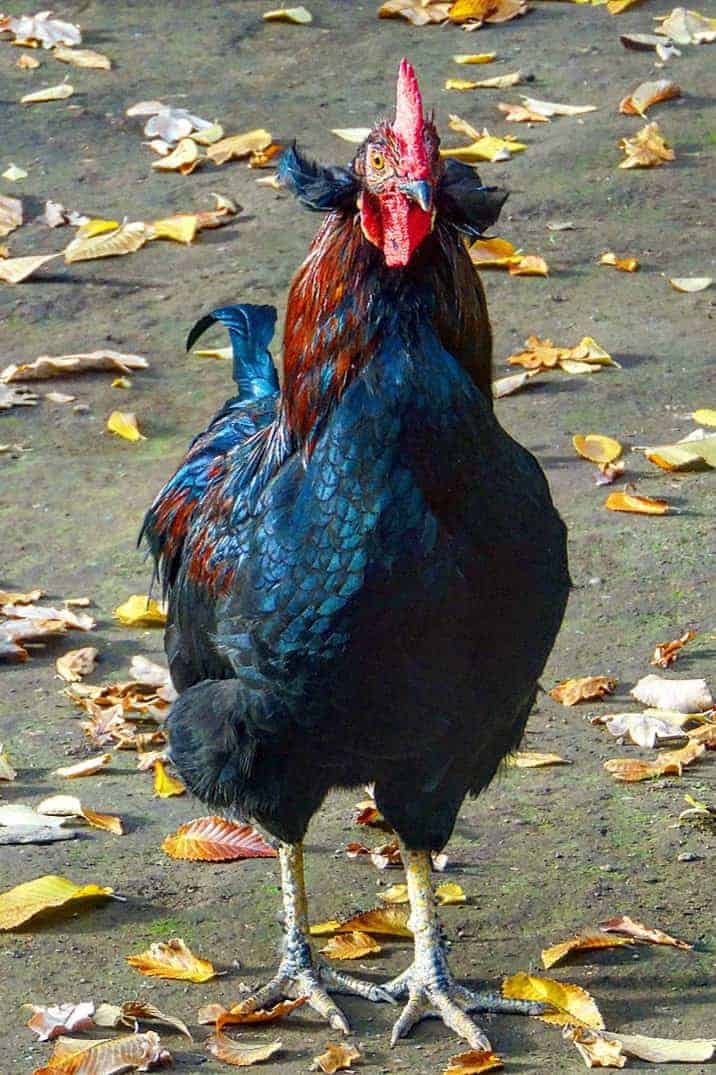
| Information | Detail |
| Purpose | Ornamental
Egg-Laying |
| Egg color | Blue
Green Pinkish |
| Egg size | Large |
| Egg production per year | Around 150 |
| Broody | Yes |
| Heat tolerance | Yes |
| Cold tolerance | Yes |
| Comb type | Pea |
| Chicken skin color | Yellow |
| Life span | 6-8 years |
| Adult weight (hen) | 4-6 lbs |
| Adult weight (rooster) | 5-7 lbs |
| Backyard friendly | 5/5 |
Araucanas are stunning chickens that create an impact both inside and outside the coop. They are attractive fowl with unique blue eggs. These hens have been produced to stand out, from their distinctive feathers to their vibrant personality. Aracauanas are excellent layers, meat birds, and daring free rangers. They make an outstanding addition to any flock.
Background and History

While its origins are unknown, Araucana hens were first identified in South America during the early twentieth century. They were named Gallina Araucana by Salvador Castello, a Spanish aviculturist who spotted them while touring Chile in 1914. Several birds were found in Chile’s Araucania region, among the Mapuche people, sometimes known as Araucanos by the Spanish.
Castello believed the chickens were an altogether new species and reported his findings at the First World’s Poultry Congress in the Hague in 1921. However, the Araucana was later determined to be a member of the same species as other domestic chickens.
Another early myth about the Araucana chicken was that its blue eggs were unique among chicken breeds. The Araucanas’ blue eggs were imported to Australia in the 1930s. In the 1980s, the breed was standardized. South American hens with blue eggs were brought to the British Isles at different points throughout the early twentieth century.
The current British Araucana traces its origins to Chilean chickens that ended up in the Hebrides due to a shipwreck. The majority of British Araucanas were raised in Scotland by George Malcolm; they were standardized in 1969 or 1974. The United States has two recognized blue egg chicken breeds.
Numerous discussions have taken place about the origins of the Araucana in the United States. It may have existed before introducing European chickens after Columbus arrived in 1492, or it may have occurred in one of the included breeds. Such lengthy discussions have proved fruitless.
Both the APA and the ABA require the Araucana to be rumpless and to have tufts of feathers protruding from both sides of the neck and head. This rumpless appearance is not due to a deficiency of tail feathers but rather to a depletion of a tailbone.
Characteristics and Temperament
Just as breeders disagree on the origins of Araucanas in the United States, there is disagreement about how this chicken’s personality is perceived. Enthusiasts assert that these blue-egg-bearing hens are among the nicest they have ever seen in a flock. Others claim that the rumpless birds are jittery and evasive.
It is maybe because the birds have a lot of activity, which can confuse nervousness, but the two are not synonymous. Those who are devoted to the breed speak about their Araucanas and their love relationships with them.
Numerous breeders who are knowledgeable about their birds suggest Araucanas as an excellent chicken for children to nurture. Young Aracaunas like being held and caressed, and birds, often handled as children, tend to be more friendly adults.
They are generally peaceful birds within the flock. They are robust and rugged, with a brooding disposition that makes them great moms. This chicken is very active and lively, a natural free-ranger who is naturally curious and maybe a bit noisy. They need somewhat more space for running than other hens their size but make the most of nature’s buffet.
8. Yokohama Chicken
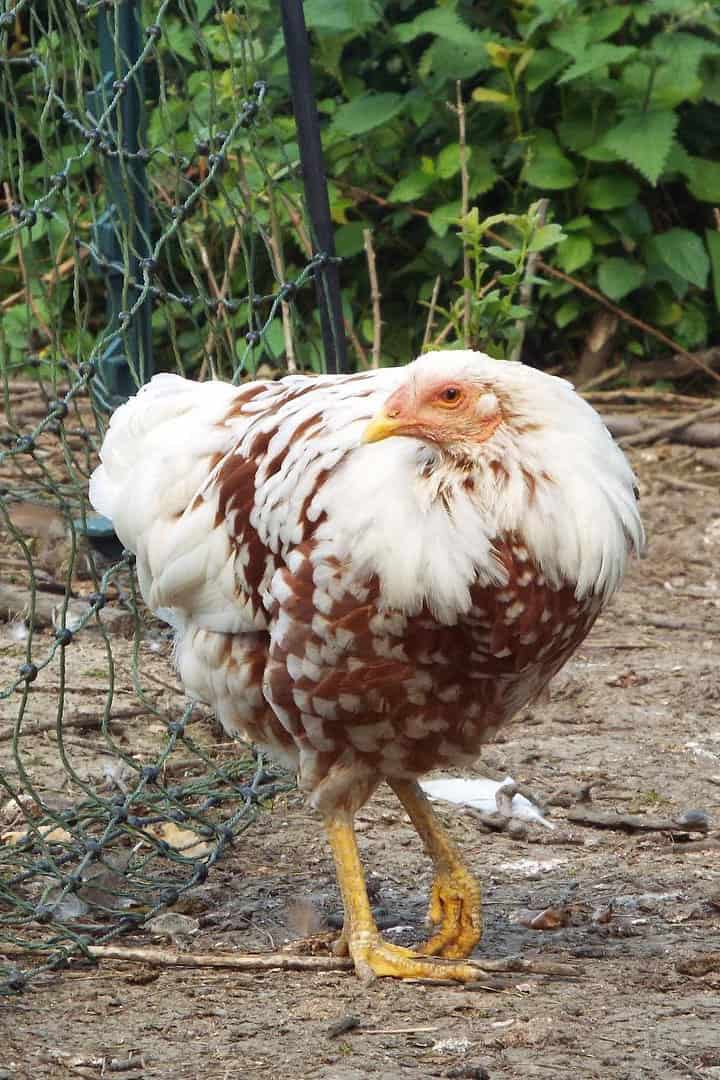
| Feature | Details |
| Purpose | Ornamental |
| Egg Color | White
Cream |
| Egg Size | Small to Medium |
| Broodiness | Not Broody |
| Heat Tolerance | Yes |
| Cold Tolerance | Yes |
| Comb Type | Single Comb |
| Egg Production | About 50 to 100 eggs per year |
| Chicken Skin Color | Yellow |
| Life Span | 6-8 years |
| Adult Weight | Hen: 5-6 lbs, Rooster: 6-7 lbs |
| Backyard Friendly | 4/5 |
The Yokohama chicken is a kind of fancy chicken that is maintained chiefly for display rather than for egg or meat production. These birds were created for their remarkable and beautiful tail feathers. Introduced to the US Standard of Perfection in 1981, the US Yokohama chicken is distinct from the British Yokohama. The Phoenix is another breed of chicken which shares some characteristics with the Yokohama, and it is recognized in both the US and across the globe.
Background and History

Although this breed is called the Yokohama, the breed was developed in Germany using Japanese birds. These birds, produced in the late 1800s, were not brought to Japan until much later in the century. Due to Japan’s near-complete isolation from the rest of the world from 1639 to 1854, international commerce would not resume until later in the century. The Yokohama port would be constructed during this period.
After being introduced to Japan from Germany, several of these chickens were moved from Yokohama port to France, where Parisian parties of interest gave them the Yokohama moniker. The Yokohama would ultimately be driven to the United Kingdom to establish a breeders’ club in 1904.
The Yokohama chicken originated in Germany and later moved to and bred in various nations; many kinds of chicken dubbed the Yokohama chicken exist today. Bantam Yokohama chickens were developed in Germany by crossbreeding chickens with bantams of multiple breeds, with the bantam chickens giving their distinctive color.
The British variation of Yokohama became well-known for both the imported Yokohama birds and what is generally regarded as the Phoenix breed, a single-comb type of chicken with colors that vary significantly from the original Yokohama.
Due to the breed’s complex history and crossbreeding with birds from various places of origin, it is unclear if the breed’s red-saddle color was developed by the German poultry organization or by breeding imported birds with birds discovered in Japan.
Regardless, the graceful bird was transported to Paris’ Jardin Zoologique d’Acclimatation in 1864, a vast museum and amusement park renowned for its extravagant presentations of natural marvels.
Characteristics and Temperament
The Yokohama chickens, often known as beautiful chickens, have been developed exclusively for captivity. As a result, the Yokohama chicken is very good at withstanding confinement. Additionally, this chicken is very gentle, which means it is unlikely to conflict with any other chicken. These hens, who thrive in the heat but are not especially tough in the winter, benefit from a well-constructed house.
Due to their gentle temperament, these chickens make excellent pets, ideal for even young children. Owners say that their Yokohama chickens are also simple to handle, often preferring to be carried and cradled above anything else.
As is the case with many chicken breeds, Yokohama roosters are more aggressive than their hen counterparts and may still be very violent when provoked, owing to their great claws.
Although these hens are developed for the show, it should be noted that their suitability for free-ranging can vary. Owners should anticipate wrangling them if they are permitted to roam freely. Due to their calm disposition, they are often either friendly or indifferent to other chickens. Their easygoing nature, on the other hand, renders them less than adept foragers.
9. Appenzeller Spitzhauben

| Feature | Details |
| Purpose | Ornamental |
| Egg Color | White |
| Egg Size | Medium |
| Broodiness | Not Broody |
| Heat Tolerance | Yes |
| Cold Tolerance | Yes |
| Comb Type | V-shaped Comb |
| Egg Production | About 150 to 180 eggs per year |
| Chicken Skin Color | Yellow |
| Life Span | 6-8 years |
| Adult Weight | Hen: 3-4 lbs, Rooster: 4-5 lbs |
| Backyard Friendly | 4/5 |
The Appenzeller Spitzhauben (which is not recognized by the APA) is a medium-sized European breed bred for egg production. Often referred to simply as Spitzhaubens, this breed produces white-shelled eggs with white skin.
This breed has just lately developed a more outstanding commitment to breeding and preservation. While this breed is accepted by organizations in the United Kingdom and many European nations, it is not supported by the American Poultry Association (APA) in the United States.
However, attempts are being made to standardize them, and a breed club has been built to facilitate this process. This breed is available in many variations, but the Silver Spangled is the most popular and is the most prevalent.
Background and History
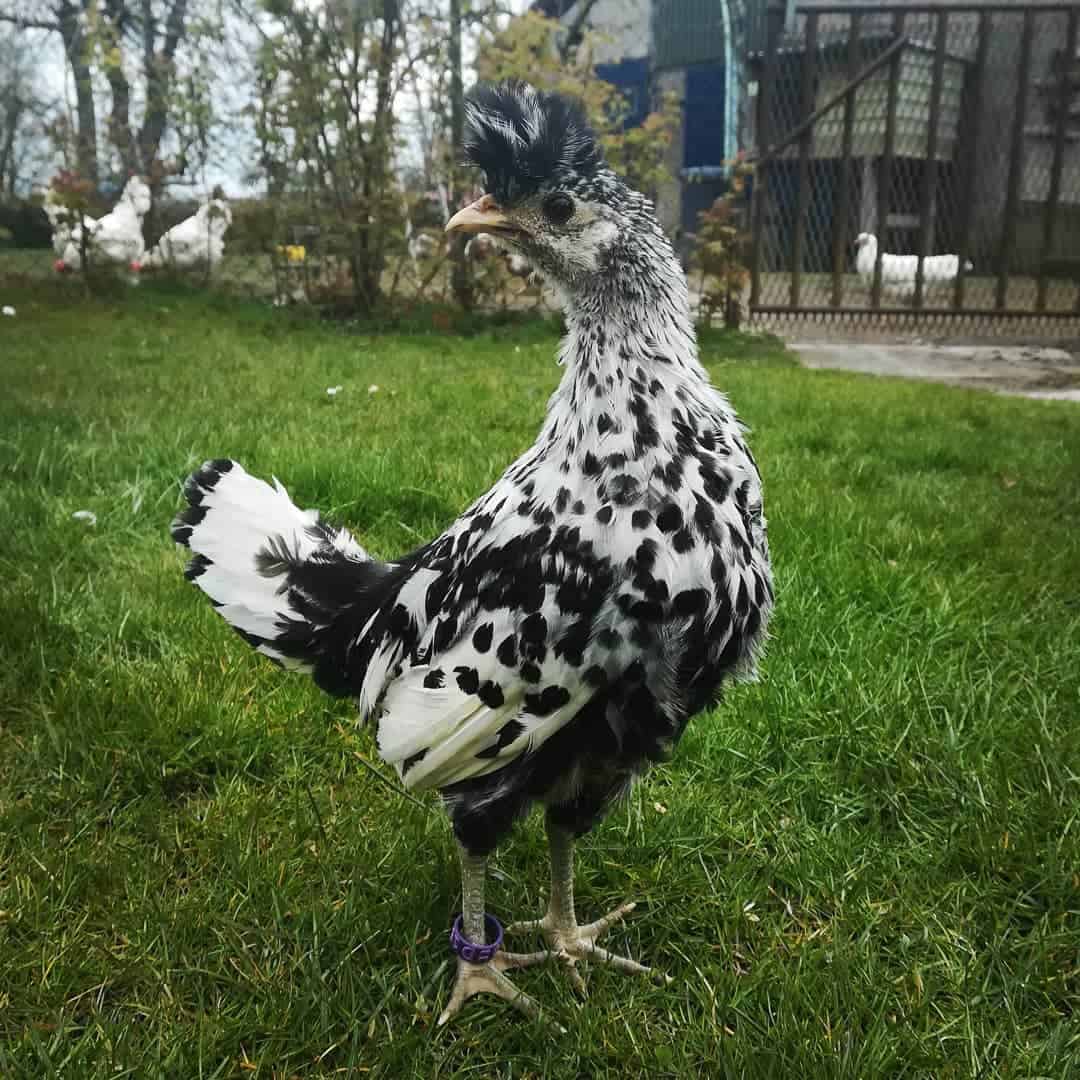
The Spitzhaubens’ early past is shrouded in obscurity. They are generally assumed to have originated in the Swiss canton of Appenzell. Since the 1600s, Spitzhaubens, or birds similar to them, have been seen in this region. They are deemed to have been developed via cross-breeding of the Dutch breed Brabanter, Crevecoeurs, and La Fleche.
Initially, the Spitzhauben were preserved in monasteries, where they were regarded as a robust foraging breed capable of laying a sufficient quantity of eggs. Initially, only these monks retained them, but the breed soon found its way into the hands of local farmers.
For many years, the breed remained confined to Switzerland, and sadly, the breed’s population had plummeted to a point where just a handful survived. None were found outside of their country until the 1800s and early 1900s. When this started to occur, it aided the breed by boosting its numbers, and the breed’s population gradually grew. However, the Second World War almost destroyed it.
It is where Spitzhauben’s current and well-documented history starts. Kurt Fischer of Germany acquired several Spitzhaubens in 1953 and started breeding them seriously.
He was influential in the Spitzhauben being accepted into the German poultry standard, and many German and Dutch breeders may be attributed with resurrecting this breed. The first Spitzhaubens arrived in England in 1978.
Breed Standard and Appearance
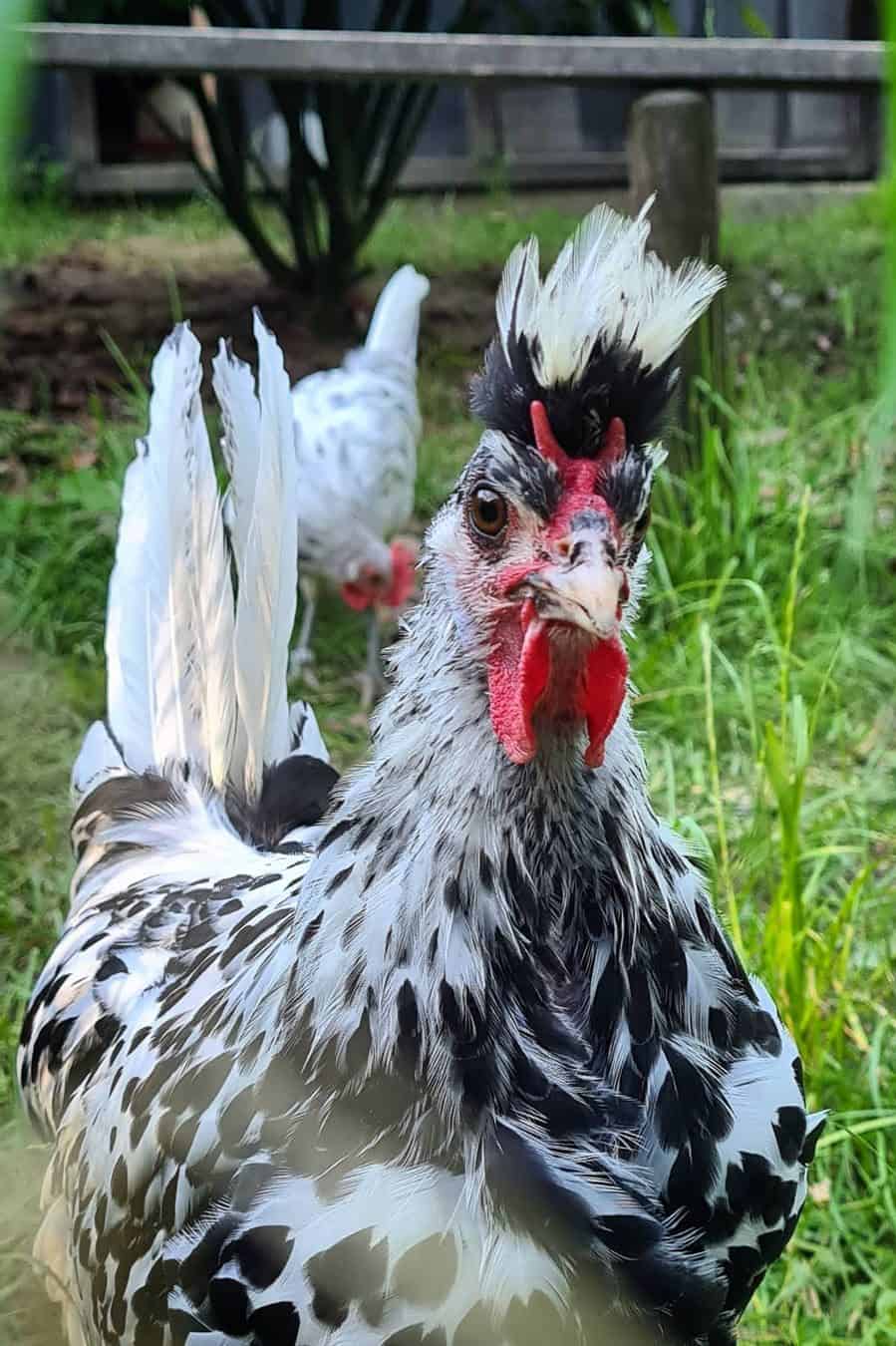
In the United States, the APA has not yet recognized this breed. The Appenzeller Spitzhauben Club of America, on the other hand, has accepted the British criteria as its proposed standards for submission to the APA.
The following is a concise overview of the standard shape and color descriptions for this breed:
- The body should be reasonably long and well-rounded, like a walnut.
- The breasts are kept high, creating a slight slant in the back from the shoulders to the tail.
- The tail should be long and widely spread and held at a straight angle to the rear.
- The shanks are medium in length, and the breed’s most remarkable distinguishing characteristic is its head.
- The comb should be V-shaped, and the nostrils cavernous; like with other crested breeds, the crest is very different from that of a Polish or Houdan.
The Spitzhauben’s ridge is medium in size and should be held upright and slightly forward rather than dropping to the sides and rear of the head. The plumage is similar to that of the Silver Spangled Hamburg, with each feather terminating in a unique black spangle and the rest being white. The beak should be bluish, the shanks slate blue, and the earlobes white.
Characteristics and Temperament
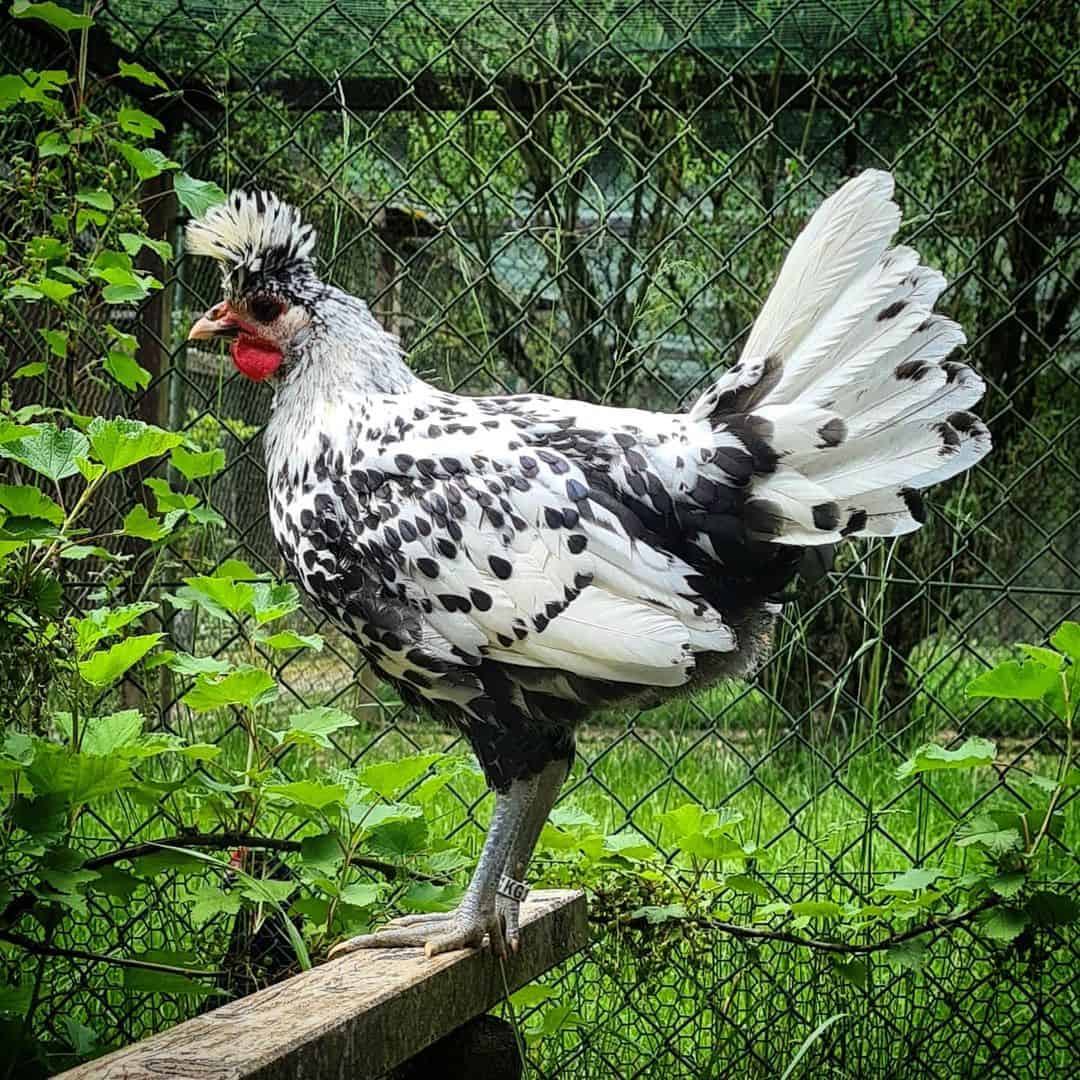
The Spitzhauben has a cheerful disposition and a tendency to be a bit flighty. These characteristics, however, contribute to the breed’s suitability as a foraging breed. If this breed has to be confined, a high fence or a cover will be required to prevent them from flying out.
If one does not want to exhibit them, they clip their wings to keep them grounded; however, this might make them more susceptible to predators that may find their way inside the birds’ enclosure.
Conclusions
Do you want to add something exotic to your coop? Or do you want to start a whole new flock of fancy chicken breeds? Any of these breeds indeed make an excellent pet for the entire family! You might prefer the furry, feathered Silkie or Frizzle or the dual purposes of the Plymouth Rock and Frizzle.
Chickens are not raised just for their meat or eggs anymore. They can now serve as great pets for kids, ornamental purposes, or for exhibitions. Whatever fancy breed you choose, it will surely bring smiles and love to you and to your coop!

Joseph Hudson has been raising chickens for over 15 years. In 2018, he completed the Agriculture & Natural Resources program at Mt. San Antonio College. He currently raises over 1400 chickens on his 7.5-hectare farm. He keeps sharing his experience on raising healthy and happy chickens on Chicken Scratch The Foundry.






